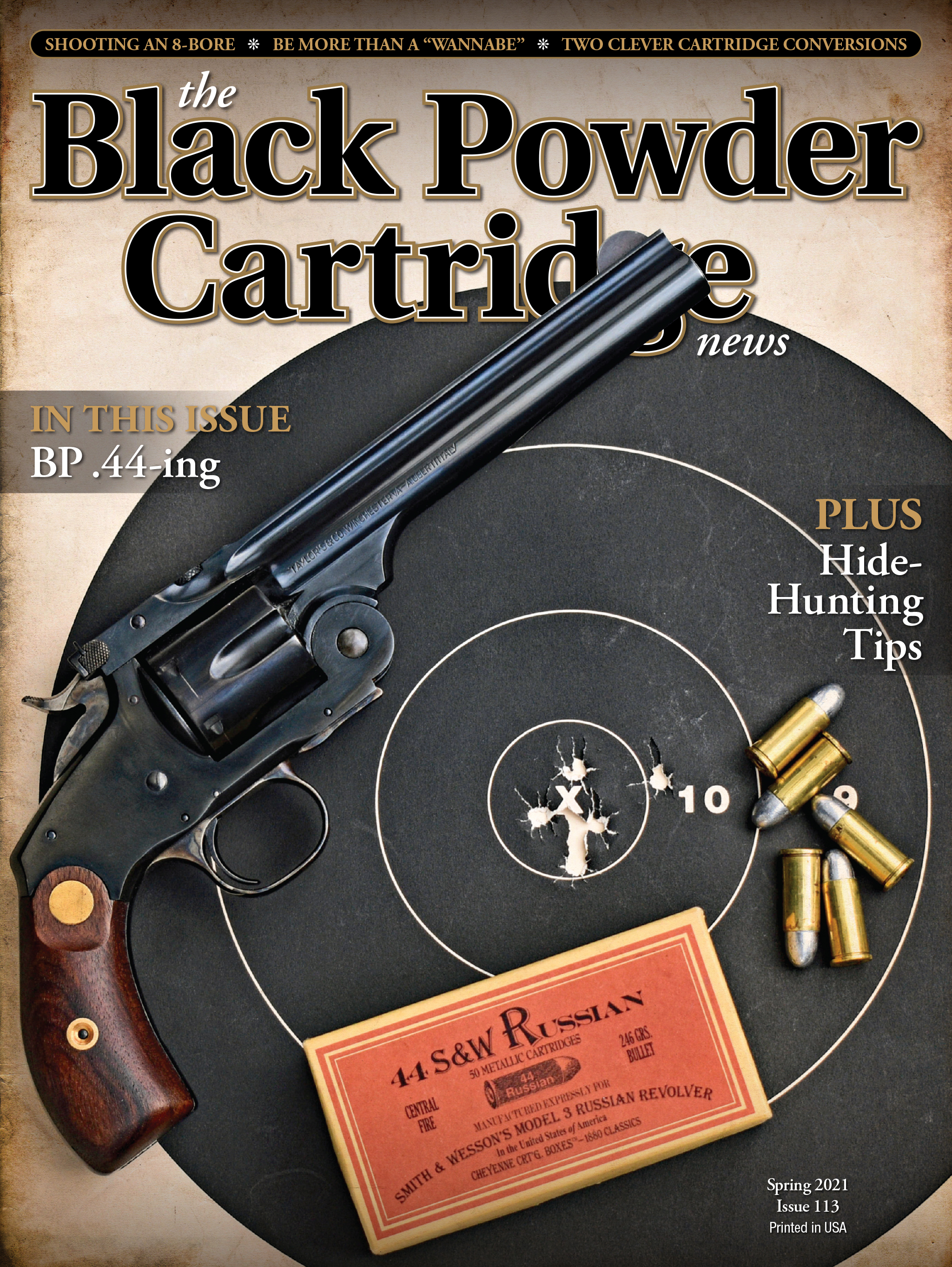Comparison of Strength of Eighteenth-Century and Contemporary Black Powder: Eprouvette Data
feature By: Herman Karl | February, 21
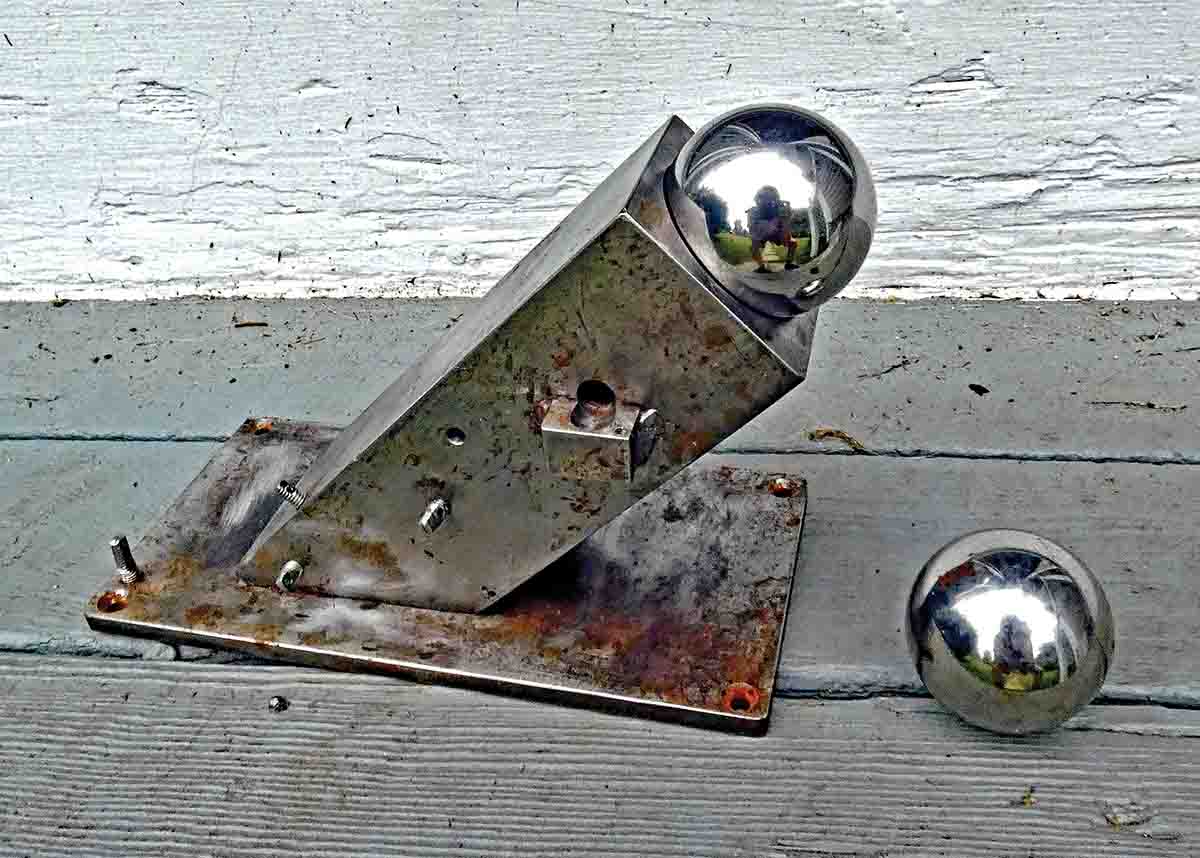
There is a great deal of speculation and controversy about the strength of eighteenth-century black powder relative to contemporary black powder. Devices called eprouvettes were developed as early as the sixteenth-century to test the strength of gunpowder (Kempers, 1998). This article presents historical data about eighteenth-century gunpowder acquired with an eprouvette and data collected with a replica of it using contemporary black powder. I know of no comparative data other than that reported in this study.
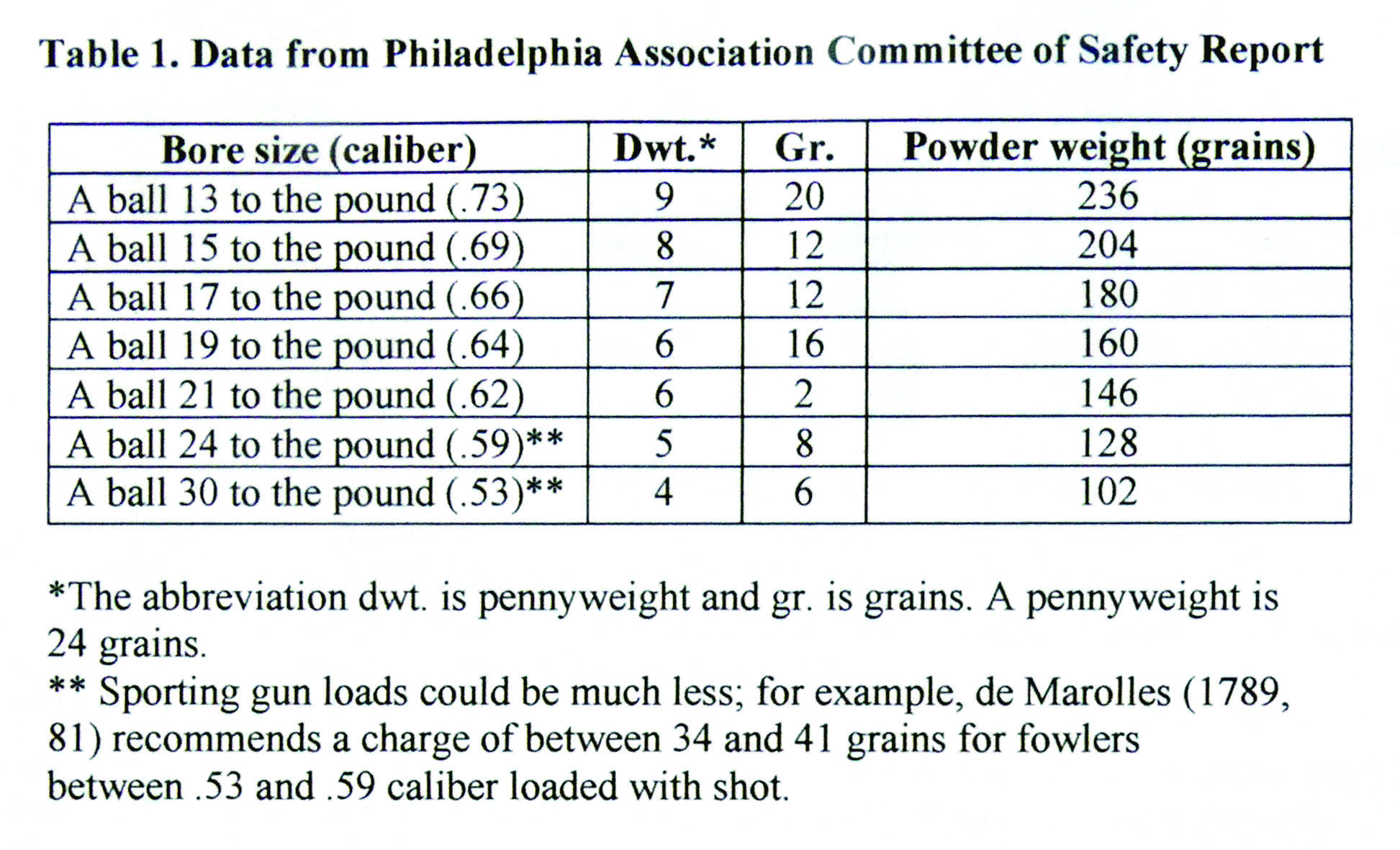
Many eighteenth-century (and later) firearms experts cautioned that data from eprouvettes were too variable to measure accurately the comparative strength of gunpowder (e.g., de Marolles, 1789, 166; Mordecai, 1845; discussion in Kempers, 1998; von Maltitz, 2010). An alternative was to fire the ball or shot into a backstop such as clay; the penetration into the backstop would be a measure of the strength of the powder (de Marolles, 1789, 172; Page, 1770, 59 ff.; Mordecai, 1845). Following publication of Robins’ 1742 treatise on the new principles of gunnery, a pendulum could be used to measure accurately the velocity of projectiles for the first time. The velocity was a proxy of the powder strength.
Some present-day researchers speculate about the strength of eighteenth-century gunpowder by interpreting records of powder charges as indicators of the relative quality (strength) of the powder. For example, they arbitrarily assume heavier powder charges suggest poorer quality and weaker powder (e.g., Klatt, 1999). There are obvious pitfalls involved with this reasoning. An example of such records is the Philadelphia Association Committee of Safety Report May 29, 1776, (Force, 1846, p. 667) that specified the powder charge should be two-fifths the weight of the ball. The report listed powder charge weights for seven bore sizes.
The above (Table 1) are heavy charges relative to contemporary standards. But what does that tell us? Was the gunpowder weaker then? Did the shooters prefer heavy charges? Were heavy charges only used for military applications? Were heavy charges used to compensate for possible differences in strength between batches of powder? A limited literature search indicates there was large variability in charge weights among firearms of the same or similar bore, which hinders accurate comparison with contemporary black powder based on charge weight. Among other factors complicating comparison is that eighteenth-century gunpowder is presumed to have varied greatly in quality, which affected its strength. As previously stated, shooters were advised to test the powder to determine its strength (e.g., de Marolles, 1789, 169 ff.; Page, 1766, 40-43; Hawker, 1833). With the exception of the data presented below, I am not aware of any record of eighteenth-century data acquired with these devices. Kempers (1998, chapter 5) describes contemporary experiments with various eprouvettes, but the purpose was to better understand the functioning of the devices.
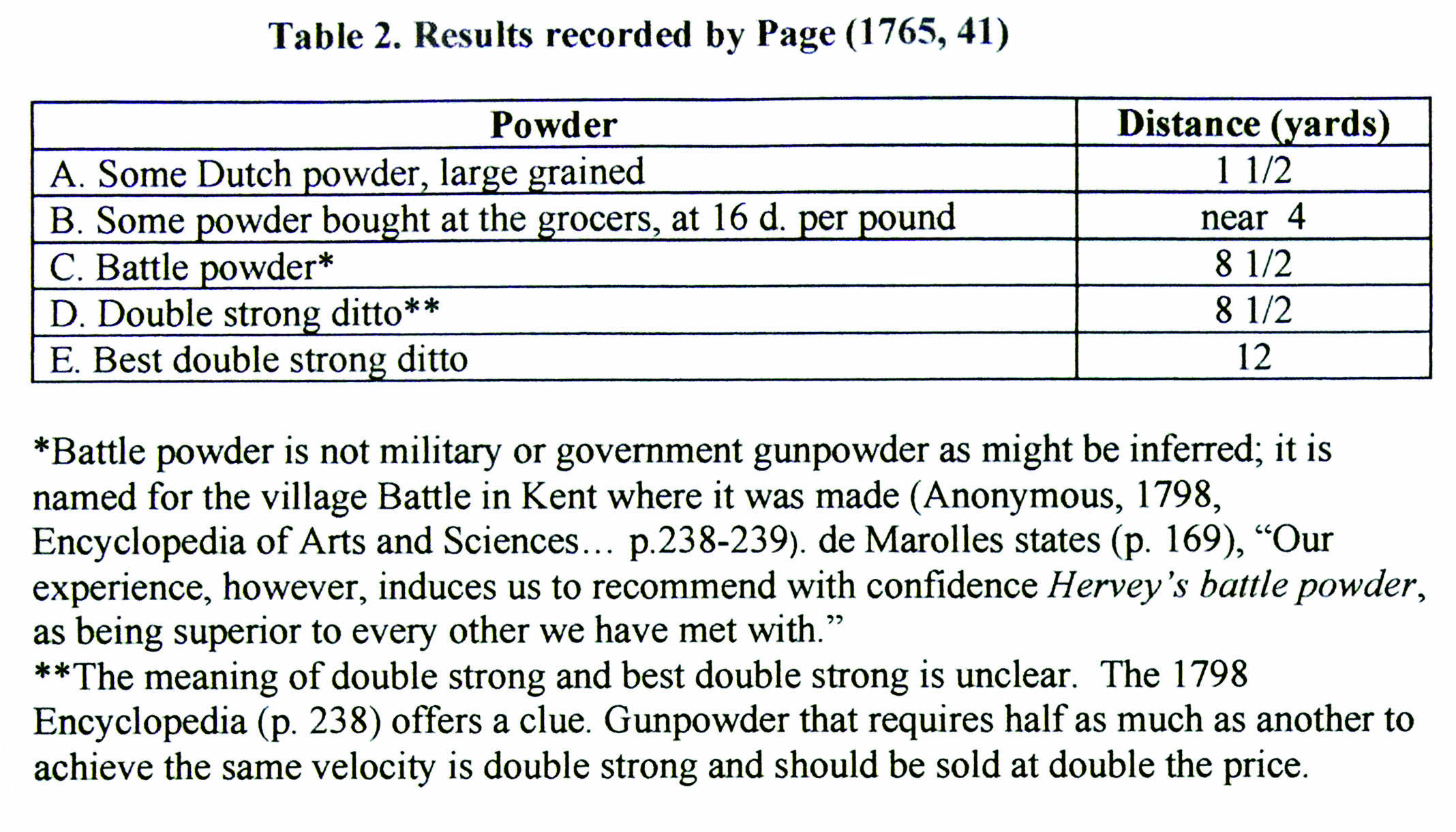
Page (1765, p. 40-43) not only described a simple powder tester (mortar eprouvette) but also recorded data acquired with it. I had Page’s eprouvette replicated with minor design changes and conducted a series of experiments to compare contemporary black powder to the five types of gunpowder tested by Page.
A fixed charge of 18 grains of black powder propels a 13-ounce steel ball. The mortar “barrel” is at a 45-degree angle. The 1¾-inch diameter ball rests in a shallow depression about one-third its diameter above the charge. The distance the ball travels is a measure of the strength of the powder (Table 2).
We do not know the granulation of these powders and cannot compare them on that basis to contemporary black powder, other than to infer, for example, that coarse Dutch powder is similar in granulation to FG.
Data Collection:
I conducted 28 trials at temperatures of 32-37 degrees Fahrenheit with two brands of contemporary black powder (Table 3). The large variability from trial-to-trial is striking, and results in overlap between granular classes. Table 4 presents a visualization of the data to grasp more easily the variation.
Discussion:
One must exercise caution when interpreting these results based on so little data. Any inferences or conclusions about these data should be guided and conditioned by the discussion that follows.
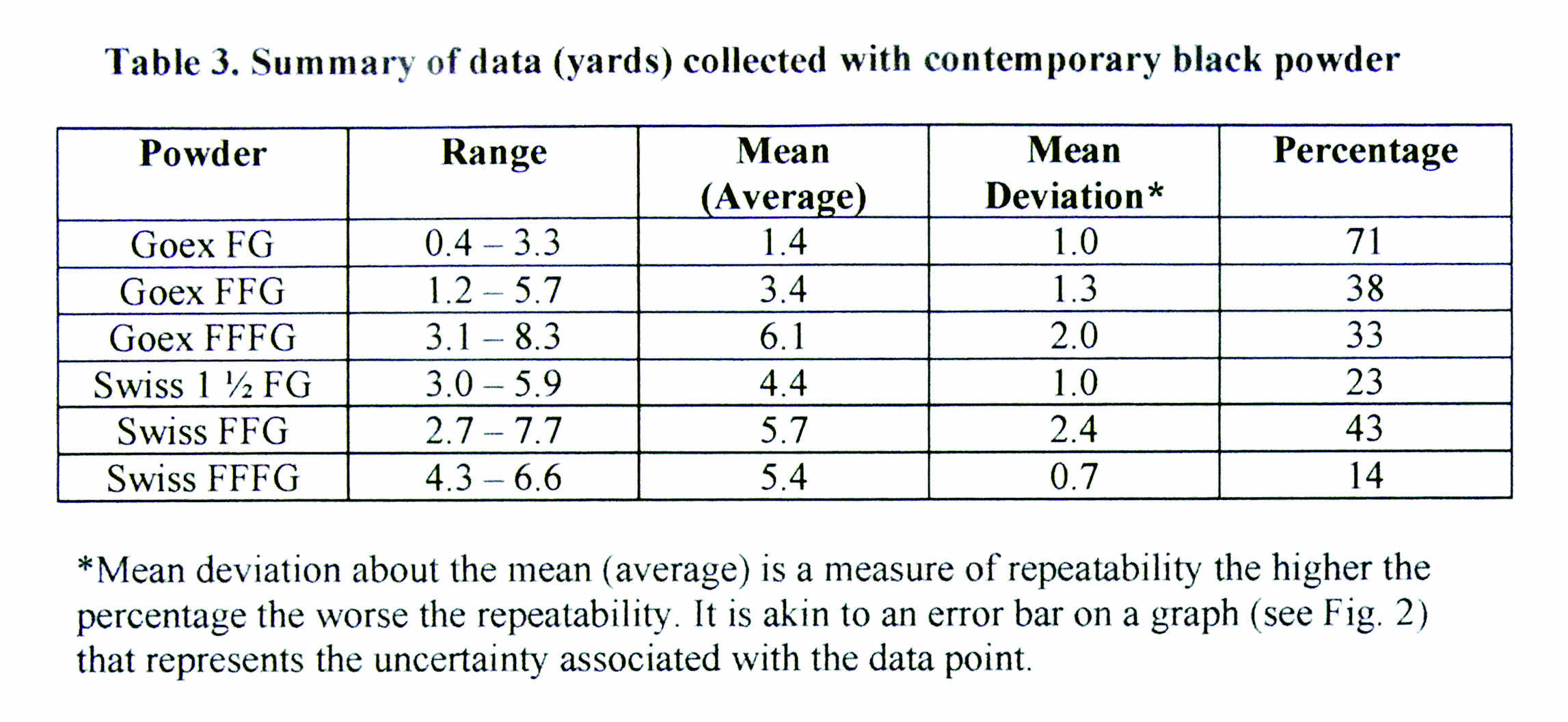
Kempers (1998, 207) stated, “It is well known that accurate results in an absolute sense can never be obtained with … [eighteenth century] tester types. The results have relative values only.” Research on and testing of black powder is severely hampered by the lack of a standard by which to compare powders, as well as the unknown accuracy, precision, and repeatability of the testing devices. As previously stated, inconsistency of results with powder testers was commonly noted during the eighteenth-century. One reason quite likely is “… quite different results are obtained when Black Powder is ignited under different conditions (von Maltitz (2010, 143)” – such as the difference between a small charge in a small chamber of a powder tester and a large charge in a gun barrel.
A discussion of historical and contemporary black powder testing techniques is beyond the scope of this paper. For a comprehensive discussion of the instruments and protocols of testing, the reader is referred to Kempers (1998) and von Maltitz (2010).
Page (1765, 41, 42) experienced variability, but was able to achieve consistent results:
“The experiments were tried first with the strong powder, which increased the second trial about a yard and a half, and third trial nearly a yard more. After which, the iron being a little warm’d, the trials with the same powder came pretty nearly alike, and each sort was tried three or four times; the ball was also carried very nearly in the same line. From which circumstances I conclude this the best method of proving gunpowder that I have yet met with.”
Even though Page concluded the mortar eprouvette is the “best method of proving gunpowder,” many researchers have criticized its accuracy (von Maltitz, 2010, 174, 175). “It is worth noting that powders…optimized for sporting firearms appear to perform woefully inadequately when tested in a mortar-type apparatus. This is because these powders are designed for high pressure applications (von Maltitz, 2010, 161).”
Comparing test results is further complicated because black powder is comprised of naturally occurring organic components, each of which may contain impurities. In the eighteenth-century, the proportion of components could be controlled during manufacture, but the purity of each could not. How much of the variation from trial-to-trial was due to the variability of the powder and how much to the testing device was not known. It could not be determined because there were no standards for gunpowder and none for the testing devices. Moreover, operator error may have also contributed to the inconsistent results.
Conclusions:
.jpg)
Page’s results apparently are the average or mean of three or four trials of each type of powder after the eprouvette had “warm’d,” so that successive trials were fairly consistent (“came pretty nearly alike”). I reported the mean of three or four trials (five trials of Swiss FFG and FFFG) of each granulation of black powder. This number of trials was insufficient to achieve reasonably consistent results, so the conclusions are preliminary. It may be the eprouvette is not capable of greater repeatability, or that igniting black powder in an essentially open vessel produces inconsistent burn rates that are the cause of the variability. (For a discussion of principles of accurate measurement see von Maltitz, 2010, 160,161). Many more trials are needed to establish whether one or the other or both is true. Nonetheless, no mean value of distance came close to the means (8½, 8½, 12 yards) of the three best powders tested by Page; these three powders form a grouping separate from all the other powders (Fig. 2). GOEX FFFG achieved the highest mean 6.1 yards of the contemporary powders and longest distance 8.3 yards in one trial. The data are too few for a robust statistical comparison, and the testing conditions with respect to those of Page are unknown. Nonetheless, I took care to duplicate the testing technique of Page, and the data suggests the best eighteenth-century powders were stronger than the best black powder today. Roberts and others (2008) concluded that eighteenth-century gunpowder was stronger than contemporary black powder. However, their assumptions are flawed and their conclusions suspect. These results ought not be interpreted as definitive with respect to the relative strengths of gunpowder then and now. They are, however, the only known hard data comparison and, thus, contribute to an informed discussion. Arguments about the relative strength of eighteenth-century and contemporary black powder are inconclusive and may remain so until more data are uncovered and/or more tests conducted. The data reported here may not provide a firm conclusion, but they can at least warn us away from blithely drawing wrong conclusions.
Acknowledgements:
Donald Hafner reviewed the manuscript, which was improved by his edits.
References:
Anonymous, 1798, Encyclopedia; or a dictionary of arts, sciences, and miscellaneous literature…v. VIII, GOB – HYD, Philadelphia, printed by Thomas Dobson, at the Stone House, no. 42, South Second Street, MDCCXCVIII, 239-240
de Marolles, M., 1789, An essay on shooting. Containing the various methods of forging, boring, and dressing gun barrels…: Ecco Print Editions, reproduction from the British Library, London, printed for T. Cadall, 303 p.
Force, Peter; “American Archives: Fourth Series.” Volume VI. Washington,1846, p, 667-668
Hawker, Peter, Lt. Col., 1833, Instructions to young sportsmen in all that relates to guns and shooting. Seventh Edition, Reprint 1986, Southampton, Ashford Press Publishing
Kempers, R.T.W. (1998) Eprouvettes: a comprehensive study of early devices for the testing of gunpowder. Royal Armories Museum
Klatt, P. E., 1999, Musket cartridges of the American Revolution. Gun Report, 45:20-24
Mordecai, A. ,1845, Report on experiments on gunpowder, made at Washington Arsenal in 1843 and 1844. Washington
Von Maltitz, I., 2010, Black powder manufacturing, testing & optimizing: American Fireworks News, 208 p.
Page, T., 1765, The art of shooting flying: familiarly explain’d by way of dialogue. Containing directions for the choice of guns for various occasions. An account of divers experiments, discovering the execution of barrels of different lengths and bores. Ecco Print Editions, reproduction from the Bodleian Library, Oxford
Page, T, 1770, The art of shooting flying’ containing directions for the choice of guns: experiments discovering the execution of barrels of different lengths and bores…the fourth edition. Ecco Print Editions, reproduction from British Library
Ramage, C. K. (ed.), 1975, Lyman Black Powder Handbook. Lyman Publications
Roberts, N.A., Brown, J.W., Hammett, B., and Kingston, P.D.F. (2008) A detailed study of the effectiveness and capabilities of eighteenth century musketry on the battlefield. Journal of Conflict Archaeology 4:1-21
Robins, B., 1805, New principles of gunnery…a new edition by Charles Hutton, Reprints from the collection of the University of Michigan Library
Endnotes:
The Lyman Black Powder Handbook (Ramage, 1975) lists loads from 20 to 150 grains FFG for a .75 caliber Brown Bess (142) and loads from 50 to 150 grains FFFG for a .50 caliber rifle (114). It seems to me these data have no value for estimating the relative strengths of the powders.
Gene Henrikson Walnut, IL (http://walnutforge.com) built the replica from a model supplied by me.
Nothing is implied nor should any inferences be made about the quality of the brands of contemporary black powder tested in this study. Contemporary manufacturers adhere to high production standards. It is unknown how much of the variability demonstrated between trials can be apportioned between the powder and the eprouvette.
Kempers (1998, 208) calculated the deviation of the mean about the average for data collected by 14 eprouvettes. The results varied from 4.4 percent to 35.8 percent. These calculations demonstrate the degree of repeatability for each device.
Col. Hawker, in the 7th edition of Instructions to Young Sportsmen, however, states (98, 99), “With regard to the strength and other good qualities of gunpowder, I shall, instead of saying anything farther, recommend the epreuvette (or powder-proof), whereby we can always be certain of finding out the best; provided that this machine is properly made, properly used, and nicely cleaned after every fire.”
Roberts and others (2008) concluded that eighteenth-century gunpowder was stronger than that today. Their conclusions depend entirely upon the authors’ premise the Brown Bess fired a ball at a muzzle velocity of 1,500 fps. The authors state there are no mid-eighteenth century velocity data for the Brown Bess (p. 4). They base their premise on historical data from two sources (one an 1845 U.S. government report), which they extrapolate to the Brown Bess used in 1745 (p. 4). This is a major weakness of the paper, and it profoundly affects their comparative analysis of the strength of eighteenth-century and contemporary black powder. They state that standard cartridges for the Brown Bess contained between 5 drams (137 grains) and 6 drams (164 grains) of powder (p. 3). Thus, by their extrapolation, it must follow that such a powder charge generated a muzzle velocity of 1,500 fps. The authors then state that because at least 15 grams (231 grains) of contemporary black powder tested by them was needed to attain an equivalent muzzle velocity, contemporary powder must therefore be weaker than eighteenth century powder. They tested three types of black powder: 3A, which is approximately equivalent to FFFG, G12 approximately equivalent to FG, and coarse blasting powder. They achieved the highest velocity with a mixture of 3A and G12. This is another weakness, which precludes a valid comparison between their results and eighteenth-century gunpowder.
Robins (1805, 92, 93) describes experiments conducted with a .77 caliber 45-inches long barrel firing a 583 grain .75 caliber ball propelled by 288 grains of gunpowder. This is the caliber and length barrel of the 1730 and 1742 Brown Bess pattern that would have been used in 1745; the ball more likely would have been about .69 caliber weighing about 495 grains, i.e., the size ball used by Roberts and others. Robins recorded a velocity of about 1,690 fps. The amount of powder is considerably greater than the amount (231 grains) of modern black powder Roberts and others concluded was needed to attain 1,500 fps. Robins (93) recorded a velocity of about 1,173 fps using 144 grains of gunpowder.
Roberts and others assumption that 1,500 fps was obtained with 137-164 grains of gunpowder is drawn into question by Robins’ experiments, and hence their conclusions are questionable that eighteenth-century powder was stronger than contemporary powder. Because Robins used a heavier ball, it might be possible that more powder was required to obtain 1,690 fps. In an attempt to attain 1,500 fps with a .69 diameter ball, the size used in the Brown Bess, I conducted a series of experiments using my 1730 Long Land Service Musket replica; the caliber is .77 and barrel 46-inches long. I constructed a series of paper cartridges loaded with a .69 diameter ball weighing 490 grain. I tested different charges of GOEX FFG in 10-grain increments from 120 to 180 grains. The 180-grain charge yielded a velocity of 1,461 fps. I tested 180 grains of FG, which produced a velocity of 1,179 fps. I suspended testing, as recoil was brutal.


